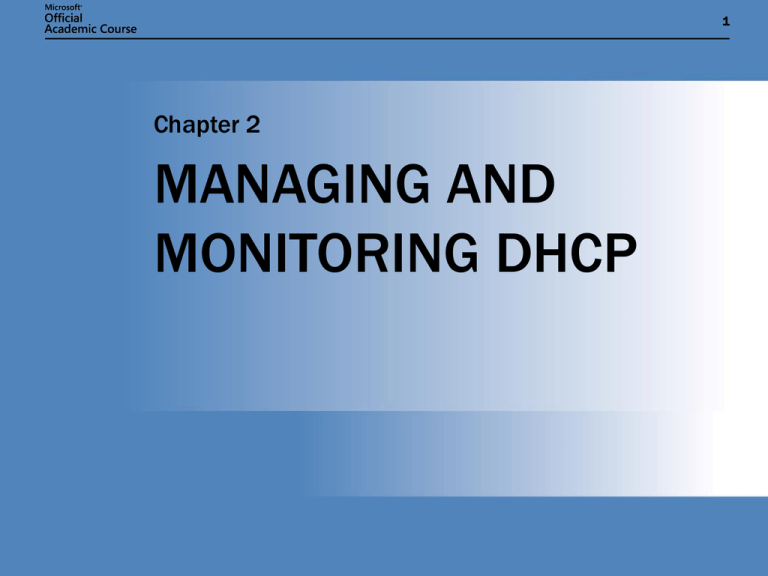1 MANAGING AND MONITORING DHCP Chapter 2 2 MANAGING
advertisement

1 Chapter 2 MANAGING AND MONITORING DHCP Chapter 2: MANAGING AND MONITORING DHCP MANAGING DHCP: COMMON DHCP ADMINISTRATIVE TASKS Configure or modify scopes Configure or modify options Configure the DHCP relay agent Back up the DHCP database Restore the DHCP database Compact the DHCP database Reconcile DHCP scopes 2 Chapter 2: MANAGING AND MONITORING DHCP 3 DNS DYNAMIC UPDATES Allows client computers to dynamically update resource records in DNS Allows DHCP to dynamically update client computer resource records Chapter 2: MANAGING AND MONITORING DHCP WHEN TO USE DYNAMIC UPDATES When the DNS client operating system is not Microsoft Windows 2000, Microsoft Windows XP, or Microsoft Windows Server 2003 When assigning permissions that allow clients to update their own records becomes unmanageable When allowing individual clients to update records presents a security risk 4 Chapter 2: MANAGING AND MONITORING DHCP DYNAMIC UPDATES WITH MICROSOFT WINDOWS 2000 AND LATER CLIENTS 5 Chapter 2: MANAGING AND MONITORING DHCP DYNAMIC UPDATES WITH PRE–WINDOWS 2000 CLIENTS 6 Chapter 2: MANAGING AND MONITORING DHCP CONFIGURING DHCP FOR DYNAMIC UPDATES 7 Chapter 2: MANAGING AND MONITORING DHCP SECURE DYNAMIC UPDATES 8 Chapter 2: MANAGING AND MONITORING DHCP 9 TROUBLESHOOTING TIPS FOR DYNAMIC UPDATES Check the servers’ system Event Log for errors. Use Ipconfig /registerdns to force a client to renew DNS registration. Ensure dynamic updates are properly enabled for the zone on the DNS server. Verify that clients’ preferred DNS server is the primary DNS server for the zone. Check the resource record access control list (ACL) on the server. The ACL must allow dynamic updates. Chapter 2: MANAGING AND MONITORING DHCP 10 TROUBLESHOOTING TIPS FOR DYNAMIC UPDATES (CONT.) Verify that the system time on the DNS server and the DNS client is synchronized. Check the client UpdateSecurityLevel registry entry. The registry entry could have been modified to prevent dynamic updates. Check to see whether the DNS zone is locked, preventing updates. Ensure that the client has permissions to update the resource records. Chapter 2: MANAGING AND MONITORING DHCP MANAGEMENT OF A DHCP DATABASE Back up and restore the database. Reconcile the database. Compact the database. Enable server-based conflict detection. Remove the database. 11 Chapter 2: MANAGING AND MONITORING DHCP 12 BACKING UP AND RESTORING THE DHCP SERVER Microsoft Windows Server 2003 supports automatic and manual backups of the DHCP database. The DHCP database and registry entries are automatically backed up every 60 minutes by default. If the original database is unable to load, when DHCP starts it will automatically restore a backup copy of the database. A manual backup can be performed. Manual backups can be used only with manual restores. Chapter 2: MANAGING AND MONITORING DHCP RECONCILING A DHCP DATABASE USING THE RECONCILE ALL SCOPES OPTION 13 Chapter 2: MANAGING AND MONITORING DHCP COMPACTING A DHCP DATABASE 14 Chapter 2: MANAGING AND MONITORING DHCP REMOVING A DHCP DATABASE 15 Chapter 2: MANAGING AND MONITORING DHCP 16 BEST PRACTICES FOR MANAGING A DHCP DATABASE Manually back up the DHCP database to a location other than the default location %systemroot%\System32\Dhcp\Backup\Jet\New. Maintain an offline copy of the backup. Chapter 2: MANAGING AND MONITORING DHCP MONITORING A DHCP DATABASE Establish a baseline. Gather DHCP data from the following locations: DHCP console DHCP audit log Event Viewer Performance console 17 Chapter 2: MANAGING AND MONITORING DHCP USING DHCP STATISTICS TO MONITOR A DHCP SERVER 18 Chapter 2: MANAGING AND MONITORING DHCP MONITORING DHCP USING THE AUDIT LOG FILES 19 Chapter 2: MANAGING AND MONITORING DHCP USING THE PERFORMANCE CONSOLE TO MONITOR DHCP 20 Chapter 2: MANAGING AND MONITORING DHCP 21 BEST PRACTICES FOR MONITORING DHCP Create a baseline. Check the standard counters for server performance. Monitor the counter for DHCP performance. Chapter 2: MANAGING AND MONITORING DHCP AUTOMATIC PRIVATE IP ADDRESSING When to disable Automatic Private IP Addressing (APIPA) Troubleshooting APIPA 22 Chapter 2: MANAGING AND MONITORING DHCP CHAPTER SUMMARY DHCP can dynamically update DNS. Dynamic updates can be secure. You must monitor and manage DHCP. 23










